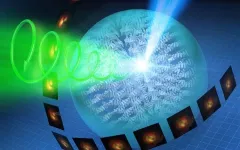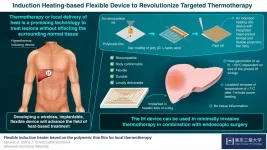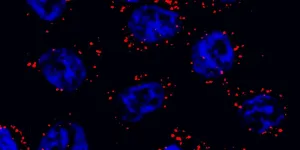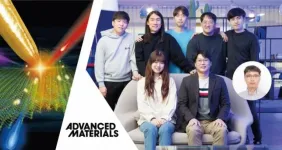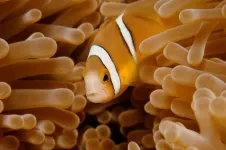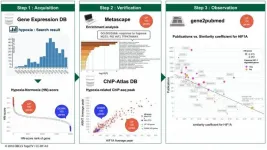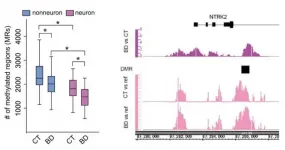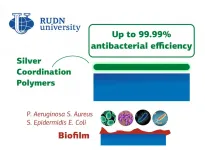Origin of fairy circles: Euphorbia hypothesis disproved
Researchers led by Göttingen University examine the long-term results of an experiment from more than 40 years ago
2021-06-09
(Press-News.org) The fairy circles of the Namib are one of nature's greatest mysteries. Millions of these circular barren patches extend over vast areas along the margins of the desert in Namibia. In 1979, G.K. Theron published the first research about their origin. His hypothesis was that poisonous substances from Euphorbia damarana leaves induced fairy circles. As part of a new study, scientists from the University of Göttingen and the Gobabeb Namib Research Institute located the original euphorbia plants that were part of Theron's study. Four decades later, the researchers are now able to conclusively disprove Theron's original hypothesis. Their results were published in the journal BMC Ecology and Evolution.
In the late 1970s, South African botanist Theron noticed several dying and decomposing shrubs of euphorbia in the Giribes area of north-western Namibia. He therefore proposed that poisonous substances from the leaves of this plant could kill the grasses and induce fairy circles and his hypothesis was published in 1979. As part of the current study, scientists went back to this same area and managed to locate the original metal pins that marked the plants. In 2020, the research team documented these remote sites in detail for the first time, using ground-based photography as well as high-resolution drone imagery and historic satellite images.
The researchers show that none of the marked euphorbia locations developed into a fairy circle. Instead, long-lived grass tussocks were growing around all the metal pins. This runs contrary to the hypothesis that poisons from euphorbia inhibited the growth of other plants because these grasses survived. Given that the euphorbia hypothesis proposes that only dead and decaying shrubs would induce a barren patch, the researchers also measured the sizes of the dying euphorbias and compared them to the sizes of fairy circles in the same study plots. As well as in Giribes, this second part of the study was also carried out at Brandberg. In both regions, the diameters of decaying euphorbias could not explain the sizes of the much smaller or the larger fairy circles. In a third part of the study, the spatial patterns of the fairy circles were directly compared to the patterns of euphorbias within the same areas to investigate a potential link between both distributions in the regions Giribes, Brandberg and Garub. However, the patterns of shrubs and circles did not match: in four out of five plots the patterns differed significantly, with the circles being regularly distributed while the euphorbias were predominantly clustered. Hence the process that creates the pattern of fairy circles is different from the process that creates the pattern of the euphorbias.
Dr Stephan Getzin, Department of Ecosystem Modelling at the University of Göttingen, summarizes, "When Theron published his original euphorbia hypothesis more than four decades ago, he was a pioneer in fairy-circle research: almost nothing was known about them at that time. Today, however, we see the long-term outcome of his early experiment and - based on our detailed field observations - we have to reject the euphorbia hypothesis." Getzin explains, "Disproving hypotheses about the origin of fairy circles is an important step in solving their mystery because it helps advance our scientific understanding. It enables us to identify more probable mechanisms which explain these stunning formations as well as other fascinating biological phenomena."
INFORMATION:
This project was possible thanks to funding from the German Research Foundation (DFG).
Original publication: Getzin, S., Nambwandja, A., Holch, S. & Wiegand, K. (2021) Revisiting Theron's hypothesis on the origin of fairy circles after four decades: Euphorbias are not the cause. BMC Ecology and Evolution, 21, 102. DoI: 10.1186/s12862-021-01834-5
Contact:
Dr Stephan Getzin
University of Göttingen
Faculty of Forest Sciences and Forest Ecology
Department Ecosystem Modelling
Büsgenweg 4, 37077 Göttingen, Germany
Email: stephan.getzin@uni-goettingen.de
http://www.uni-goettingen.de/en/112105.html
[Attachments] See images for this press release:

ELSE PRESS RELEASES FROM THIS DATE:
2021-06-09
A University of Oklahoma doctoral student, graduate and undergraduate research assistants, and an associate professor in the Homer L. Dodge Department of Physics and Astronomy in the University of Oklahoma College of Arts and Sciences are lead authors on a paper describing a "changing-look" blazar - a powerful active galactic nucleus powered by supermassive blackhole at the center of a galaxy. The paper is published in The Astrophysical Journal.
Hora D. Mishra, a Ph.D. student, and faculty member Xinyu Dai are lead authors of the paper, along with Christopher Kochanek and Kris Stanek at the Ohio State University and Ben Shappee at the University of Hawaii. The paper represents the findings of researchers from 12 different institutions who participated ...
2021-06-09
Tsukuba, Japan - Holographic displays help add a three-dimensional--and thus more life-like--feel to what would otherwise appear as a two-dimensional image. Now, researchers in Japan have tested how this may work on a supramolecular level; such tests could lead to improved displays.
Commonly, one cannot overlay a certain type of molecular component that underlies helically arranged liquid crystals onto their molecular mirror images, much like a person cannot overlay their two hands and have them match up exactly without flipping one over. Molecules with this property are described as "chiral." Some materials make use of the principle of chirality to rotate light in a plane perpendicular to the direction of the light wave, known as circular ...
2021-06-09
Researchers from the Singapore University of Technology and Design (SUTD) have developed novel techniques, known as Automated Fibre Embedding (AFE), to produce complex fibre and silicone composite structures for soft robotics applications. Their work was published in IEEE Robotics and Automation Letters.
Many soft robot components, including sensors and actuators, utilise embedded continuous fibres within elastomeric substrates to achieve various functionalities. However, manual embedding of continuous fibres in soft substrates is challenging due to the complexities involved in handling precise layering, and ...
2021-06-09
Thermotherapy or heat treatment can help in treating lesions and other tissue injuries. For example, chemotherapy or radiotherapy, when combined with thermotherapy, kills tumorous cells more effectively. Thermotherapy is considered a promising approach for treating internal lesions, but the advancement in the field depends on the availability of patient-friendly heat-inducing devices capable of rapidly increasing the temperature of target tissues.
Current clinical practices around thermotherapy majorly employ heat-generating devices that are probed inside ...
2021-06-09
DALLAS - June 9, 2021 - A phenomenon in which an RNA named NORAD drives a protein named Pumilio to form liquid droplets in cells, much like oil in water, appears to tightly regulate the activity of Pumilio. A new study led by UT Southwestern scientists suggests that such RNA-driven "phase separation," in turn, protects against genome instability, premature aging, and neurodegenerative diseases, and may represent a previously unrecognized way for RNAs to regulate cellular processes.
"It's becoming more and more clear that phase separation is an important organizing ...
2021-06-09
A research team, led by Professor Kyoung-Duck Park in the Department of Physics at UNIST has succeeded in investigating and controlling the physical properties of naturally-formed nanoscale wrinkles in two-dimensional (2D) semiconductors. This is thanks to their previously-developed hyperspectral adaptive tip-enhanced photoluminescence (a-TEPL) spectroscopy. This will be a major step forward in developing paper-thin, ultra-flexible displays.
Wrinkles are an inevitable structural deformation in 2D semiconductor materials, which gives rise to spatial heterogeneity in material properties, according to the research team. Such structural deformation has long been considered one of the top technical challenges in semiconductor manufacturing, as this would harm the uniformity ...
2021-06-09
Young clownfish living closest to shore are dying faster than those further offshore because they are being exposed to artificial lighting, says an international research team.
Working on the reefs around Moorea in French Polynesia, scientists from France, the United Kingdom, Chile and Australia found that nearshore juvenile clownfish living in anemones under lights had higher mortality than juveniles in anemones not exposed to artificial light.
The scientists also found that the surviving clownfish grew 44 per cent more slowly than clownfish under natural lighting conditions.
Professor Stephen Swearer, a marine ecologist, from the University of Melbourne, ...
2021-06-09
Scientists have leapt over the emerging problem of publication bias within genetic research by performing a meta-analysis of publicly available databases of 'transcriptomes', or the full range of messenger RNA molecules produced by an organism. Researchers from Hiroshima University applied the technique to their own field--the study of the genes that are activated when an organism experiences low-oxygen conditions--but it should also be applicable in any other fields that make use of the transcriptome, providing a powerful weapon against the threat posed by publication bias.
The meta-analysis technique ...
2021-06-09
A research collaboration based in Kumamoto University, Japan has revealed the DNA methylation status of gene transcriptional regulatory regions in the frontal lobes of patients with bipolar disorder (BD). The regions with altered DNA methylation status were significantly enriched in genomic regions which were reported to be genetically related to BD. These findings are expected to advance the understanding of the pathogenesis of BD and the development of therapeutic drugs targeting epigenetic conditions.
BD is a mental disorder that affects about 1% of the population and requires long-term treatment. Epidemiological studies have ...
2021-06-09
RUDN University chemist with his colleagues from Portugal has developed two types of coating based on new coordination polymers with silver. Both compounds were successfully tested against four common pathogens. The results are published in ACS Publications (ACS Appl. Mater. Interfaces).
Due to the rapid mutation, harmful microorganisms constantly adapt to new antibiotics and antiseptics. It is especially difficult to destroy bacteria when they form a biofilm. They stick together and create a community ready to fight antimicrobial agents back. Coordination polymers (scaffolds made of metal ions and organic ligands) can solve this problem. They prevent pathogens from ...
LAST 30 PRESS RELEASES:
[Press-News.org] Origin of fairy circles: Euphorbia hypothesis disproved
Researchers led by Göttingen University examine the long-term results of an experiment from more than 40 years ago


